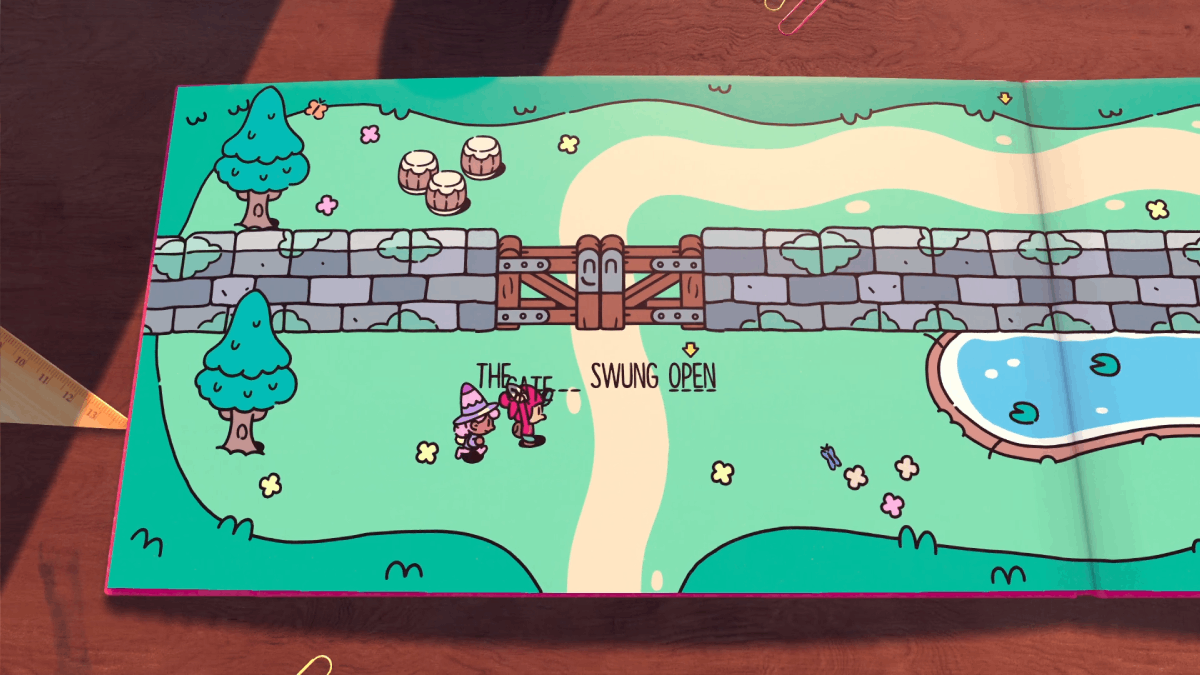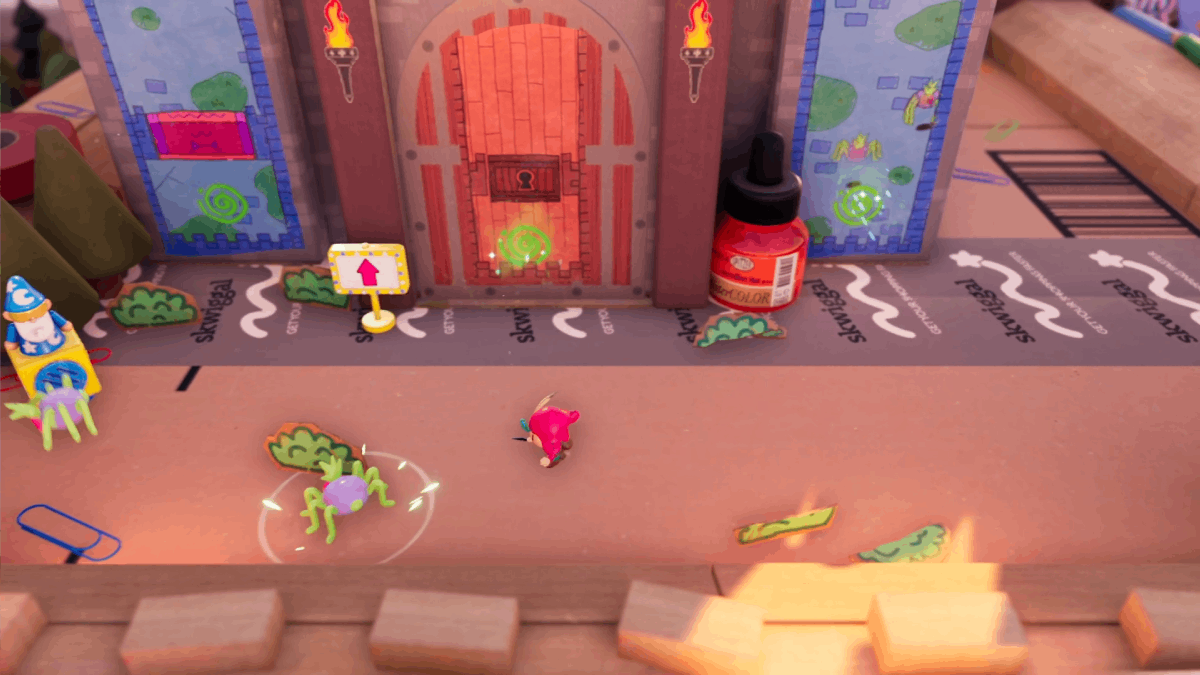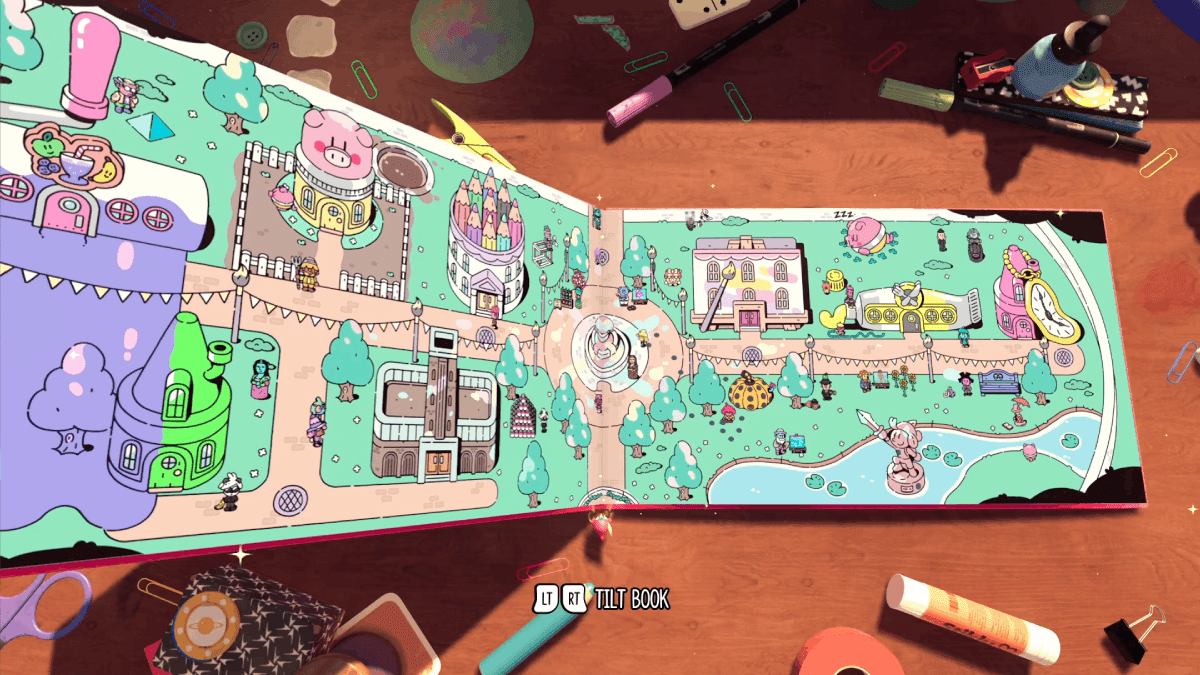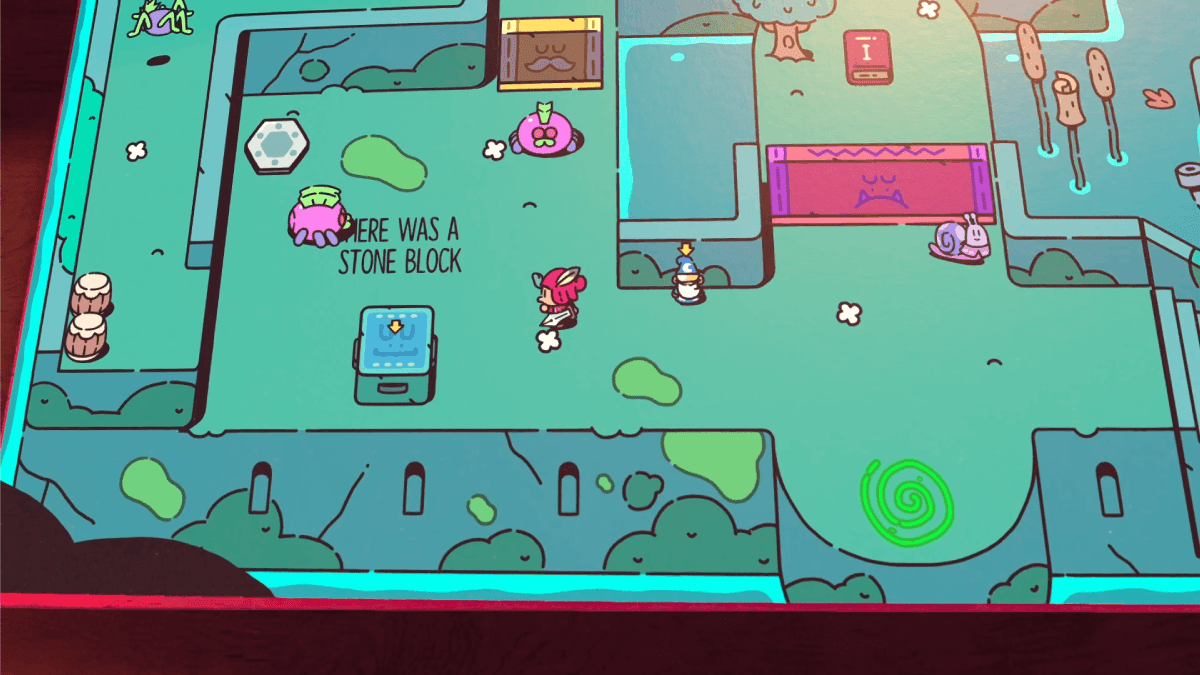The Plucky Squire has an intriguing premise. You are the titular Squire, a young man named Jot, who is on a quest to defeat the evil wizard Humgrump. However, the entire adventure takes place within a child’s storybook, and as the adventure progresses, Jot finds a way to leave the book and head out into the real world.
There are essentially two narratives at play here. The first is the story of the book itself, where Jot the Plucky Squire does battle with a fiendish foe and saves the day like the hero he is. The second is one involving the child who owns the book, quietly building an extra adventure around their room, allowing Jot to traverse the paint pots, books and mugs that line this kid’s desk. And if Jot fails in his mission, there’s a real chance that this child may never see their creativity flourish in the future.

The gameplay in The Plucky Squire is similar to the 2D Zelda games. In fact, it’s easy to see a direct line between the storybook sequences drawing influence from A Link to the Past while the real world segments draw more from the Switch remake of Link’s Awakening. You explore the world, moving from page to page, battling enemies in a simple combat system while occasionally solving puzzles to progress.
There are some inventive puzzles here too. The game makes good use of its meta narrative, with Jot having to use his abilities to leave the book for a variety of purposes. Sometimes he has to retrieve an item from an earlier page, manipulate the words on the page or physically tilt the book to move something heavy.
You’ll also get sequences where you get to explore the desk, where Jot can jump in and out of doodles on Post-It notes, clamber over stationery and interact with characters and worlds outside of his own. There’s one moment involving an obvious yet legally distinct Magic the Gathering card that got a genuine chuckle out of me because of how much the art styles contrasted with one another.

This is where The Plucky Squire shines. There’s an abundance of imagination here, with the world outside the book reminiscent of LittleBigPlanet or Yoshi’s Crafted World, as our tiny protagonist clambers over hand-crafted levels. It’s all falling apart at the visible seams and yet it’s endearing and warm. Wandering these sequences, you can see the hidden child behind all this, imagining they’re sending their favourite character on a mighty quest across their desk. Occasionally dinosaurs and space aliens can just show up on a whim because that’s what this kid is into today. As someone who was glued, sometimes literally, to art shows on TV when I was growing up, I always appreciate games that bring back that unique brand of childhood creativity in their design ethos.
That’s not to say the storybook itself lacks this same imagination. The world of Mojo is a silly one in all the best ways. They developers have crammed so many interesting locations into limited page space, and populated it with a weird and wonderful bunch of side characters. There’s the population of Artia, who are all based on famous painters and artists, or the trolls whose entire culture is built around heavy metal. They’re all endlessly charming, and the world is drawn with a vibrant and colorful art style. It’s easy to see the animated series they could spin off from this.
The game even throws occasional minigames at you that completely change the genre. There’s a Punch-Out!! knockoff, rhythm games and even a match-3 puzzle game, among others. They don’t always work as well as their inspirations, but the shift is always a welcome one. They show off the team’s imagination even more, and the way they’re woven into the narrative and given a Plucky Squire interpretation is always entertaining.

Despite all this, though, The Plucky Squire has a serious problem with linearity. For a game that so heavily celebrates creativity and imagination, it feels jarring that it barely lets the player be creative or imaginative in how they approach the game. There’s nothing wrong with linear games, and I’ve enjoyed plenty of them. However, the reason it stands out so much here is because of how determined the game is to keep you on a narrow path at all times, while hinting at possibilities that are just not there.
Puzzles typically have a single solution, one that’s usually telegraphed in obvious ways. Portals between fiction and reality only show up where they need to. The desk in the real world shrinks to nothing when the focus needs to be on the book. The game even actively takes your abilities away when it decides you don’t need them at that moment. I lost count of how many times my attempts to manipulate the book saw my ability to tilt it just…disappear.
It’s frustrating, because there’s so much promise for more. The steady acquisition of abilities suggests the room outside the book could have been an open space that only restricted your movement based on abilities, Metroidvania-style. I would have loved to explore more freely and see a greater contrast between the linear storybook and the infinite possibilities living outside it.

I also would have loved more experimentation with the puzzles. I would often unlock an ability, consider the many things I could do with it, only to find the ability is often worthless outside the specific story beats the game wants it to be used. I often wanted to flip back through the book and uncover secrets after obtaining an ability or new knowledge. On rare occasions I would be rewarded for this, but most of the time I’d simply be slowly turning through the pages only to have to slowly turn them all back, my curiosity entirely unfulfilled. There’s also one distinct puzzle later in the game where I had to break a box, but my thought process of smashing it into a wall with the tilt function didn’t work. The “correct” solution did make sense, but the lack of acceptance of creative alternatives was disappointing.
The main reason all this bothered me so much is simply because The Plucky Squire set up such a lovely little world. Both the fictional world of Mojo and the neat little touches of the real world were interesting. I want to explore them both a lot more, and see how far the concept can go. The team at All Possible Futures have crafted something wonderful here but it also feels like we’re only seeing a fraction of what they’re capable of.
Of course, if you’re just here for a fun linear adventure, you’ll have a blast. The Plucky Squire is an imaginative romp full of joy and wonder despite how much it holds your hand in the process.
The Plucky Squire is out now for PC, PS5, Nintendo Switch and Xbox Series X/S.
The Plucky Squire
The Plucky Squire is an imaginative romp full of joy and wonder despite how much it holds your hand in the process.
Pros
- I did encounter a few serious glitches during my playthrough, once which almost made my save file unplayable (thankfully, the game made backups!). Hopefully this will be fixed for launch.
- The wizard Moonbeard is easily the best character, mostly because he knows how to lay down some sick beats.
- The game's sole collectible is pages from a cute little artbook detailing behind-the-scenes info, which I really liked.